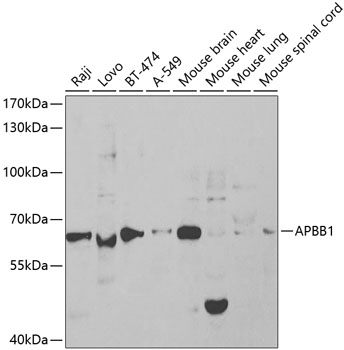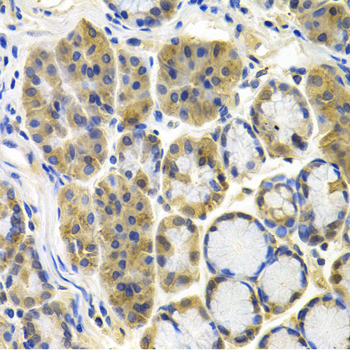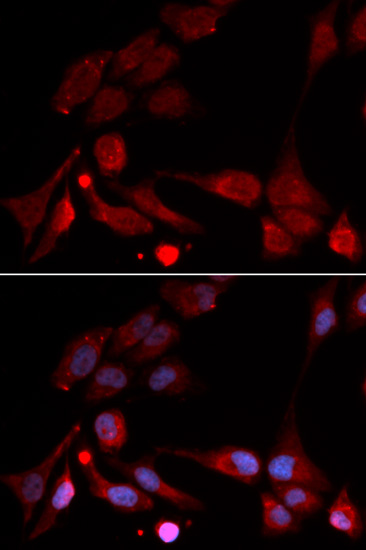-
Product Name
APBB1 Polyclonal Antibody
- Documents
-
Description
Polyclonal antibody to APBB1
-
Tested applications
WB, IHC, IF
-
Species reactivity
Human
-
Alternative names
APBB1 antibody; FE65 antibody; MGC:9072 antibody; RIR antibody; amyloid beta precursor protein binding family B member 1 antibody
-
Isotype
Rabbit IgG
-
Preparation
Antigen: Recombinant fusion protein containing a sequence corresponding to amino acids 359-708 of human APBB1 (NP_663722.1).
-
Clonality
Polyclonal
-
Formulation
PBS with 0.02% sodium azide, 50% glycerol, pH7.3.
-
Storage instructions
Store at -20℃. Avoid freeze / thaw cycles.
-
Applications
WB 1:50 - 1:200
IHC 1:50 - 1:200
IF 1:50 - 1:200 -
Validations

Western blot - APBB1 Polyclonal Antibody
Western blot analysis of extracts of various cell lines, using APBB1 antibody at 1:1000 dilution.Secondary antibody: HRP Goat Anti-Rabbit IgG (H+L) at 1:10000 dilution.Lysates/proteins: 25ug per lane.Blocking buffer: 3% nonfat dry milk in TBST.

Immunohistochemistry - APBB1 Polyclonal Antibody
Immunohistochemistry of paraffin-embedded human colon carcinoma using APBB1 antibody at dilution of 1:100 (40x lens).

Immunofluorescence - APBB1 Polyclonal Antibody
Immunofluorescence analysis of U2OS cells using APBB1 antibody . Blue: DAPI for nuclear staining.
-
Background
Transcription coregulator that can have both coactivator and corepressor functions. Adapter protein that forms a transcriptionally active complex with the gamma-secretase-derived amyloid precursor protein (APP) intracellular domain. Plays a central role in the response to DNA damage by translocating to the nucleus and inducing apoptosis. May act by specifically recognizing and binding histone H2AX phosphorylated on 'Tyr-142' (H2AXY142ph) at double-strand breaks (DSBs), recruiting other pro-apoptosis factors such as MAPK8/JNK1. Required for histone H4 acetylation at double-strand breaks (DSBs). Its ability to specifically bind modified histones and chromatin modifying enzymes such as KAT5/TIP60, probably explains its transcription activation activity. Function in association with TSHZ3, SET and HDAC factors as a transcriptional repressor, that inhibits the expression of CASP4. Associates with chromatin in a region surrounding the CASP4 transcriptional start site(s).
Related Products / Services
Please note: All products are "FOR RESEARCH USE ONLY AND ARE NOT INTENDED FOR DIAGNOSTIC OR THERAPEUTIC USE"
